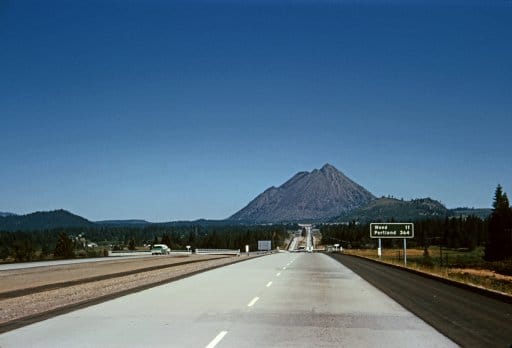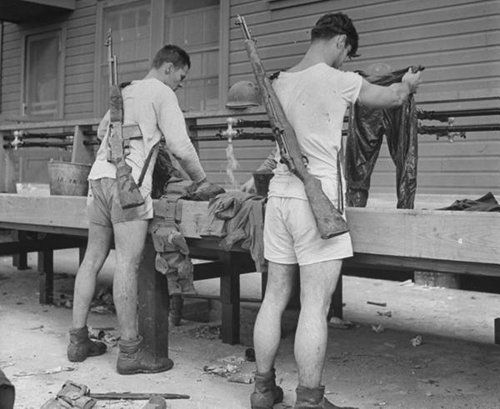
Editor’s note: This is a guest post from Jeff More.
You’re packing for a road trip and you’re down to deciding how much clothing to bring. You could have a fresh change of clothes every day, but that adds up to a lot of space quickly, especially if you have multiple companions. You really would prefer to travel light, but that means either finding a laundromat and spending a stack of quarters and a few hours in town, or hand washing your clothes at camp when you could be kicking back and enjoying a foil meal instead.
Or you could just suck it up, not change, and reek a little. But really, you’re car camping, not backpacking, so why do that? What’s a man to do?
Here’s a tip I got from Travels with Charley (sadly missing from the Art of Manliness’ 100 best reads, but no one’s perfect), John Steinbeck’s 1962 travelogue documenting his road trip circumnavigating the Lower 48 with his French poodle, Charley, and how the American landscape had changed over his lifetime. The book is known for its series of poignant tales, but buried inside is a handy nugget on how to effortlessly have a fresh change of clothes on hand daily while on the road.
What You’ll Need:
- 5-gallon bucket with lid (I use an orange Home Depot bucket)
- Jug of clean water (Get a jug with a screw-on top, not a snap top. Trader Joe’s has a good one.)
- Laundry detergent
- Some utility cord or other improvised clothesline
- Clothespins or binder clips (the duct tape of office supplies)
Here’s how it works.
In the Morning
“[I] put in two shirts, underwear, and socks, added hot water and detergent, and hung it by its rubber rope to the clothes pole, where it jigged and danced crazily all day.” -John Steinbeck, Travels with Charley
When you’re breaking camp, throw your dirty clothes into your five gallon bucket. Fill up your bucket with enough water to cover your dirty laundry and put some detergent in there. I usually use a half load or less of powdered detergent pre-measured at home and stored individually in baggies (alternatively, you could get a squeeze bottle at REI for a dollar for liquid detergent) so it doesn’t get overly soapy, as you’re only doing a small load relative to what you regularly would do at home.
Secure the lid and place the bucket somewhere in your vehicle where it won’t tip over. Steinbeck hung his bucket from the clothes pole in his trailer. I have a wagon with a seating capacity of five and place the bucket behind the passenger seat.
As you drive along, every curve and bump in the road agitates the load, acting as the wash cycle as the contents slosh around. As you can imagine, the technique outlined in this article works better on winding roads than cruising on the high speed straightaways of the interstate.
At Lunch
“That night I rinsed the clothes in a stream, and you’ve never seen clothes so clean.”
Steinbeck rinsed his clothes in a stream at camp, but depending on where you’re camping, there is a probability you may or may not have access to one (the Sierra Nevada in May has lots of running water–the Mojave Desert in November does not), but no worries.
When you stop for lunch, pour out the nasty gray water, pour in a little fresh water from your jug, and massage your clothes a few times, getting most of the waste water out. Refill the bucket one last time again with enough fresh water to cover your clothes and refill your clean water jug somewhere—campgrounds and gas stations are good options–remembering to keep ample water in your car in case of emergency.
As you continue on down the road, this acts as the rinse cycle.
At Camp
“Inside Rocinante I strung a nylon line close to the window and hung the clothes to dry. From that time on, my clothing was washed on one day of driving and dried on the next.”
If you decide to skip the rinse method above and stick to rinsing your clothes in a stream at camp like Steinbeck, be mindful if you’re at a populated campground. It’s best not to send sudsy water downstream to your neighbors, even if the soap you are using is biodegradable, as your neighbors may be using that same water to drink and cook with. Use your best judgment.
When you arrive at camp, pour out the water and gently wring out the clothes. Steinbeck let his clothes air dry over the next day, but if you have been wearing modern synthetic outdoor garments, you could speed up the process. Thick, heavy cotton clothes will dry the slowest, while thin synthetics like Patagonia Silkweight Capilene or Ex Officio travel underwear will dry the quickest. Wool socks fall somewhere in the middle, but, unlike cotton, will retain warmth and loft even if slightly damp.
Improvise a clothesline with some utility cord using a combination of your car’s oh-crap handles and/or baby seat attachment points, or any other secure points your vehicle has to offer. If you’re certain there will be no precipitation overnight, you could also rig up the line between some trees. As the ecology of most places I typically camp in the desert regions of California and the Southwestern states don’t lend themselves well to big trees, I don’t bother, but if it’s an option, a breeze will help speed things up. Secure your clothes using clothespins or binder clips.
Depending on ambient humidity levels, your clothes may or may not be perfectly dry in the morning, but if they’re not satisfactorily dry, no worries, leave them hanging in your vehicle and let them dry out on the next day’s driving just like Steinbeck did.
Congratulations, you smell fresh! If you have any tips on how to do laundry on a road trip, be sure to post them in the comments section.
Keep the adventure alive!
_________________________________
Jeff More works and resides in Los Angeles, where the four seasons are mudslides, earthquakes, riots, and wildfires. He is an avid shooter of both firearms and camera, and celebrates his American heritage by playing the 5-string banjo. Check out his website at www.skunkabilly.com.







